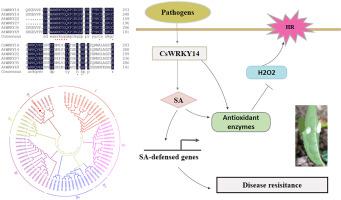Physiological and Molecular Plant Pathology ( IF 2.8 ) Pub Date : 2021-05-14 , DOI: 10.1016/j.pmpp.2021.101667 Shuyuan Liu , Qiqi Zhang , Changfei Guan , Daying Wu , Tianshan Zhou , Youben Yu

|
Blister blight, caused by Exobasidium vexans Massee, is a serious tea disease and leads to massive damage to tea yield and quality. WRKY transcription factors play an important role in the regulation of biotic stresses. However, the biological and molecular functions of these transcription factors during blister blight in tea plants are not known. The present study isolated a disease resistance gene, CsWRKY14, from leaves of Camellia sinensis and analysed this gene using bioinformatics. The results demonstrated that CsWRKY14 comprised multiple cis-acting elements and involved in salicylic acid (SA) signal transduction pathway. Moreover, the CsWRKY14 protein belongs to the IIe subgroup of the WRKY family located in the nucleus. The expression of CsWRKY14 was more upregulated in the resistant cultivar ‘Zhongcha 108’ (ZC) compared to the susceptible cultivar ‘Longjing changye’ (LJ). Consistently, the endogenous levels of SA and the expression of SA signaling pathway-related genes (NPR1, PR1, PR2, and PR4) were higher in ZC than in LJ, which suggests that CsWRKY14 contributes to the increase of SA concentration and activates the expression level of SA-induced pathogen-associated genes. Histochemical analysis and enzymatic activity assay revealed that the resistant cultivar ZC exhibited less H2O2 accumulation and higher activities of antioxidant enzymes. CsWRKY14-silenced plants were more sensitive to E. vexans than wild plants and exhibited a decrease in the expression of SA pathway-related genes and the antioxidant enzyme activities. Our results suggest CsWRKY14 can be used as an effective genetic resource for tea breeding against blister blight.
中文翻译:

转录因子WRKY14介导茶树(山茶)对水疱病的抗性
由Exobasidium vexans Massee引起的水泡枯萎病是一种严重的茶病,会严重损害茶的产量和品质。WRKY转录因子在调节生物应激中起重要作用。但是,这些转录因子在茶树枯萎病期间的生物学和分子功能尚不清楚。本研究从山茶的叶片中分离出了一种抗病基因CsWRKY14,并使用生物信息学对该基因进行了分析。结果表明CsWRKY14包含多个顺式作用元件并参与水杨酸(SA)信号转导途径。此外,CsWRKY14蛋白属于位于细胞核中的WRKY家族的IIe亚组。与易感品种“ Longjing changye”(LJ)相比,在抗性品种“中cha108”(ZC)中CsWRKY14的表达上调。一致地,ZC中SA的内源水平和SA信号通路相关基因(NPR1,PR1,PR2和PR4)的表达高于LJ,这表明CsWRKY14有助于增加SA浓度并激活SA诱导的病原体相关基因的表达水平。组织化学分析和酶活性分析表明,抗性品种ZC表现出较少的H 2 O 2积累和较高的抗氧化酶活性。与野生植物相比,CsWRKY14沉默的植物对埃克森美孚大肠杆菌更敏感,并且其SA途径相关基因的表达和抗氧化酶活性均下降。我们的结果表明,CsWRKY14可作为茶抗水疱病的有效遗传资源。











































 京公网安备 11010802027423号
京公网安备 11010802027423号